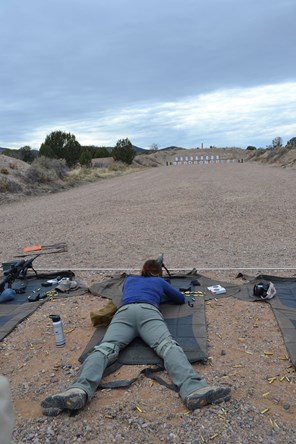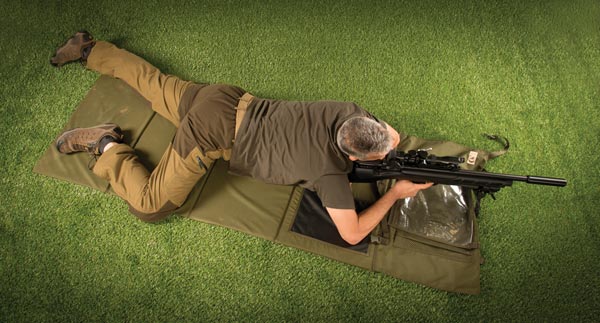By George Emanuel
I’ll try to answer that question, and adjust as necessary.
“What do you mean by adjust? breathing is breathing.”

No, my friend, while we may take it for granted, it is not all the same.
Pay attention to your breathing as you sit in your recliner, dreaming about all the things you should be doing, or would like to be doing. Perhaps if you weren’t concerned about breathing so easily maybe you could get off your butt and bring a couple of those to fruition. But I digress.
There is a correct way to breathe, but it varies. In “Bullseye Shooting,” for example, we have all of the time in the world, compared to “defensive shooting,” where someone is returning fire. The two systems are mutually exclusive.
Now, allow me to expand the conversion slightly, but appropriately, to encompass both pistols and rifles. (Shotgun, we’ll lump in with rifle for now)
Where science can help us understand concepts to improve our shooting, I like to incorporate it to enhance our understanding, in the belief that sound understanding leads us more quickly to sound results. Disagree if you want, but that’s my story, and I’m going with it!
In your recliner, you are relaxed. Run 100 yards, if you can, and you are likely to be out of breath.
Now you may understand that you are breathing much harder and faster. But, do you understand what that means and its effect when shooting?
Some of you are rolling your eyes. Stop that right now!
If you are strictly a defensive shooter, you can stop here. In a gunfight (should you ever be so unfortunate to find yourself in one ) you will be far more concerned with living, which will be a natural benefit to your breathing.
If, on the other hand, you are pursuing accuracy, it will significantly benefit you. It may be the most significant key in history right behind Pandora’s.
Now an exercise. Concentrate your thoughts on your breathing as you inhale and exhale. I will verbalize what you need to feel. We’ll get to why in a moment.
Breathe in, think of a roller coaster, gently rising to the top of the trestle, almost pausing as it passes the apex, before descending into the valley at the bottom, where it is slowed and loses momentum quickly. The energy necessary to pull it up or control its descent is now absent. It is resting, getting prepared for the next cycle.
You breathe in, reach the top of your cycle, exhale to the bottom, where things level off, and before inhaling again to restart the cycle, there is a brief pause. This is called the “Respiratory Pause” and is an integral part of firing an accurate shot.
For our purposes here today, I will use a rifle as our arm of choice, as it exaggerates the motion created by our breathing. But make no mistake, this is not exclusive to rifle accuracy. It is integral to all accuracy.
Accuracy is achieved when all of the principles of marksmanship are correctly applied and executed. When executed consistently, we achieve repeatability. (Yes, you can violate any of the principles as long as you do so consistently; however, without a map to follow, it is impossible to measure your level of consistency.) so quit chasing your damn tail and follow the roadmap which millions of shooters have practiced before you were a twinkle in daddy’s’ eye.
When you breathe, your diaphragm, one of the most significant muscles in your body, which you have control over, needs to be a substantial consideration in firing the shot. It burns considerable amounts of oxygen, which depletes the available supply to critical organs, such as your brain and eyes.
Hold your breath for a long enough time, and your vision will blur. What you don’t sense is that it began to blur long before your brain sent the message. Your eyes consume a considerable amount of oxygen. As an added bonus, while discussing the acuity of the eyes, hydration is equally important. Stay hydrated, and remember, “if you ain’t peein’ you ain’t seein’.
OK now, let’s push onward,
The ideal time to take our shot is during the respiratory pause at the end of the breathing cycle. This ‘pause’ is a 3-5 second affair, plenty of time to execute the trigger squeeze.
Imagine, for illustration, you are lying prone with your rifle. The modern prone position (see the above picture) involves spreading the feet and positioning the body perpendicular to the target, with the toes outward and the heels on the ground. This puts the body in the lowest position possible and presents the smallest target to an enemy. This is the modern military method, but it is not the most accurate.

The older or legacy position involves the body being 15 degrees or so to the line of the target, with the support leg extended straight and in line with the spine. The trigger leg is bent at about 90 degrees and pulled up to a level or slightly less than the hip. This position raises the trigger side chest and DIAPHRAGM clear of the supporting surface, thus mitigating most of the rise and fall found in the modern position and reducing the pressure on the internal organs, allowing them to transmit less disturbance to the shot as their movement is compensated by the position, making the platform steadier for the shot. It is also physically more comfortable as those organs are not externally compressed. But this is not the end. Bear with me, you WILL SHOOT BETTER!
OK, place the support elbow directly under the rifle, (I hope you are using a sling, with the shooting elbow bent and comfortably to the side. (think kickstand).
Your trigger hand is used to fire the shot and may also assist in pulling the rifle into your shoulder to help control recoil.
This is where the magic happens, so get your visualization skills out.
If you have set yourself up in this position and the position is naturally aligned with the target (NPOA natural point of aim), your front sight will rise and fall vertically, dead center, up and down in the target. (Another article later will describe how to adjust all of this.)
Your front sight should be positioned so that you achieve a dead-center sight picture at your respiratory pause, allowing you three to five seconds to press the trigger without disturbing the sights.
If your front sight is high at the pause, scoot your hips forward slightly; if the sight’s line up low, scoot back slightly. The support elbow is planted and does not move. Your body moves AROUND this pivot point.
Stillness is primary for accuracy; it cannot be faked, nor can it be anything less than perfect. This stillness is maintained for a period after the bang, which is known as follow-through. That means all aspects of firing the shot for a period long enough for you to say “follow through” after the shot mentally. If you don’t want to follow through, you will NEVER be a great shot! Period, full stop, done, the end of discussion!
I will leave you in closing with this. After the shot, the holes are in the target, and unless the target is moving, neither are the holes. Follow through, the holes will still be there when you walk downrange.
And the target NEVER lies. It is what you did! All it does is record results, no more, no less. Suppose the holes are not where you intended. Look in the mirror, don’t stand there muttering, “I can’t believe it.” And no, there isn’t enough Budweiser on the planet to change it. Bragging is lying, only with extra confidence!
Next time, “Getting and Using Natural Point of Aim,” this is perhaps 75% of the shot, and when achieved, it is the magic bullet that will carry you to success.
Til then, keep it pointed in a safe direction,
George